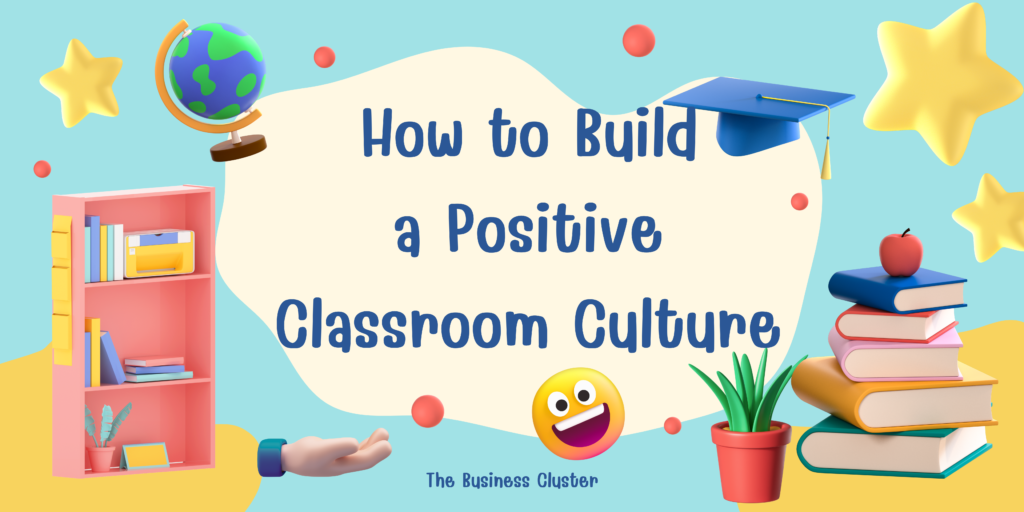Creating a positive classroom culture is essential for both students and teachers. Moreover, a warm and supportive environment helps students feel safe and motivated. In addition, it makes teaching more enjoyable and effective. Therefore, this blog will guide you step-by-step through practical tips, tricks, and tools to build a positive classroom culture that benefits everyone.
Why is Classroom Culture Important?
Classroom culture greatly affects learning. When students feel valued, they engage more. In addition, positive cultures promote trust, cooperation, and respect. As a result, they also help reduce behavioral problems. Consequently, teachers find it easier to manage classrooms with a positive vibe.
Building this culture, however, takes time and effort. Nevertheless, the rewards are absolutely worth it. Let’s now explore how you can make it happen.
Tips to Build a Positive Classroom Culture
1. Set Clear Expectations
Start the year by setting expectations. Discuss rules and values with students. Use simple language. For example:
- Be kind to everyone.
- Raise your hand before speaking.
- Respect others’ opinions.
Let students share their ideas. This creates a sense of ownership.
2. Use Positive Reinforcement
Praise good behavior often. Simple words like “Great job!” or “Thank you for helping!” can boost confidence. Use rewards like stickers or certificates. Positive feedback encourages students to repeat good actions.
3. Build Relationships
Get to know your students. Learn their names quickly. Show interest in their hobbies and dreams. Greet them warmly every day. Small gestures like asking, “How was your weekend?” build trust.
4. Encourage Collaboration
Group activities promote teamwork. Assign roles like leader, note-taker, or timekeeper. This helps students learn to respect each other. Collaborative tasks make lessons fun and engaging.
5. Promote Inclusivity
Make sure every student feels included. Avoid favoritism. Celebrate diversity. For example:
- Use stories from different cultures.
- Create activities where everyone can participate.
6. Be Consistent
Stick to your rules. If a rule is broken, address it calmly. Consistency builds trust. Students should know what to expect from you.
7. Model Positive Behavior
Be a role model. Show kindness, patience, and respect. Students often imitate their teacher’s behavior.
Tricks to Make it Easier
- Use Visual Aids: Display posters with positive messages like “Be kind” or “Teamwork makes dreams work.”
- Incorporate Games: Use games to teach values like cooperation and respect.
- Classroom Jobs: Assign tasks like watering plants or organizing books. This builds responsibility.
- Daily Check-Ins: Use a mood chart or a simple “How are you feeling today?” exercise.
Special Offer for All Teachers Click Here.
Checklist: Are You Building a Positive Culture?
Use this checklist to assess your progress:
- Expectations are clearly stated and understood.
- Positive reinforcement is used regularly.
- Students feel valued and included.
- Collaborative activities are part of lessons.
- Rules are applied consistently.
- Positive behavior is modeled by the teacher.
Self-Assessment: Reflect on Your Progress
Ask yourself these questions:
- Are my students comfortable sharing their thoughts?
- Do I give enough praise and encouragement?
- Have I learned something new about each student?
- Do I address conflicts calmly and fairly?
- Does my classroom feel like a safe space?
If the answer to any question is “no,” identify what can be improved.
FAQs
1. What if a student disrupts the class often?
Address the behavior privately. Try to understand the cause. Use positive reinforcement to encourage better behavior.
2. How can I involve shy students?
Pair them with a buddy. Assign small tasks to boost their confidence. Celebrate their achievements, no matter how small.
3. What should I do if a rule is repeatedly broken?
Discuss the rule with the student. Help them understand why it’s important. Use logical consequences instead of punishment.
4. How can I manage cultural differences in the classroom?
Learn about your students’ backgrounds. Celebrate cultural events. Encourage students to share traditions with the class.
5. What if students don’t respond to positive reinforcement?
Be patient. Keep trying different methods. Involve parents if needed. Building trust takes time.
Actionable Step: Start Now!
Start building your positive classroom culture today. Identify one tip or trick from this blog and try it tomorrow. Reflect on the results. Share your progress with other teachers.
Ready to transform your classroom? Join our teacher community for more resources, tips, and support. Click here to connect!
Furthermore, You can click here to read “Simple Classroom Management Tips for New Teachers“
Conclusion
You’ve learned how to create a positive classroom culture. Specifically, we talked about setting expectations, using positive reinforcement, and building relationships. Furthermore, you now have a checklist and self-assessment to guide you along the way.
Remember, it’s okay to take small steps. After all, progress is always better than perfection. Additionally, keep reflecting and improving as you go.
I’m confident you can do it! Without a doubt, your students are lucky to have you.

